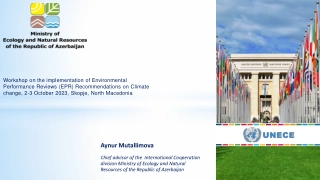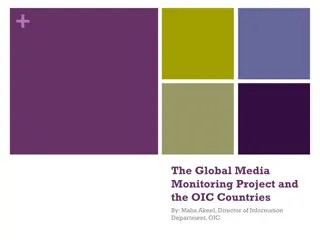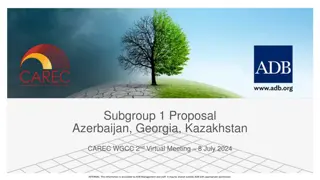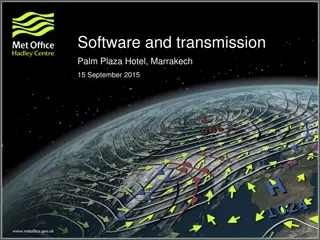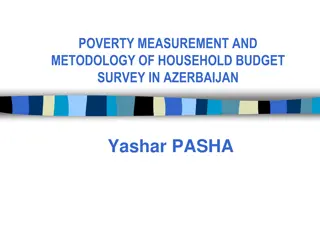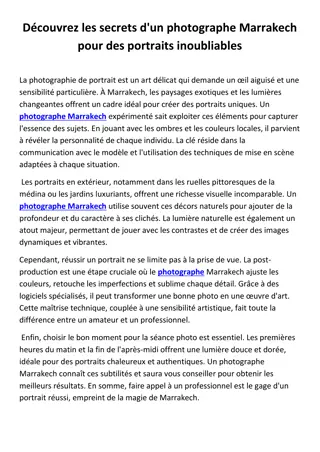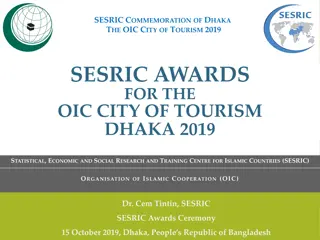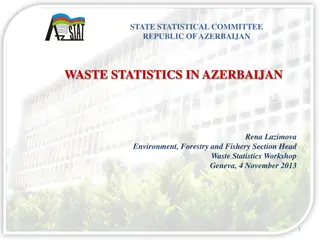
Television and Radio Broadcasting in Azerbaijan Overview
Explore the history and current landscape of television and radio broadcasting in Azerbaijan, including information on the first radio and television programs, major broadcasters, regulations, and more. Learn about the evolution of the industry and key developments in this dynamic media sphere.
Download Presentation

Please find below an Image/Link to download the presentation.
The content on the website is provided AS IS for your information and personal use only. It may not be sold, licensed, or shared on other websites without obtaining consent from the author. If you encounter any issues during the download, it is possible that the publisher has removed the file from their server.
You are allowed to download the files provided on this website for personal or commercial use, subject to the condition that they are used lawfully. All files are the property of their respective owners.
The content on the website is provided AS IS for your information and personal use only. It may not be sold, licensed, or shared on other websites without obtaining consent from the author.
E N D
Presentation Transcript
Presentation by Presentation by Fazil (NTRC, Legal and International Relations Department, Senior advisor) (NTRC, Legal and International Relations Department, Senior advisor) Fazil H.Novruzov H.Novruzov December, 2013 December, 2013 Television and Radio Television and Radio Broadcasting in Azerbaijan Broadcasting in Azerbaijan
The history of Azerbaijan radio began in twenties of last century. transmitter in Baku was installed in 1924 and in 1926 the first radio station began to transmit. The first radio The first television programme in Azerbaijan began to broadcast on February 14, 1956.
9 nation-wide television broadcasters: 1) AZTV (state-run channel) 2) Culture Azerbaijan (state-run channel) 3) Sport Azerbaijan (state-run channel) 4) ICTIMAI (public service broadcaster)
5) ANS TV (private broadcaster) 6) Space TV (private broadcaster) 7) Lider TV (private broadcaster) 8) ATV (private broadcaster) 9) Khazar TV (private broadcaster)
1 satellite broadcaster Caspian Broadcasting Company CBC (private) 14 nation-wide radio broadcasters 12 regional TV broadcasters 12 cable network broadcasters
Till 2002, television and radio broadcasting sphere was regulated by the Law of the Republic of Azerbaijan On mass media of July 21, 1992. On August 6, 1998 the President of the Republic of Azerbaijan signed the measures to protect freedom of speech, thought and access to information in the Republic ofAzerbaijan . Decree On additional
At a moment, television and radio broadcasting in the Republic of Azerbaijan is regulated by the Law of the Republic of Azerbaijan On Television and Radio Broadcasting adopted in 2002. However, public broadcasting is regulated by the Law of the Republic of Azerbaijan On Public Television and Radio Broadcasting adopted in 2004.
Applying of administrative measures on broadcasters is regulated by the Code of the Republic of Azerbaijan onAdministrative Infringements. During elections agitation and election propaganda in television and radio are regulated by Election Code. By the Decree of the President of the Republic of Azerbaijan dated October Television and Radio Council of the Republic of Azerbaijan (The Regulatory Authority in the sphere of television and radio broadcasting) was established. National 5, 2002
National Television and Radio Council is created in 2002. The Council is consisting of 9 members which are appointed by the President of Azerbaijan for the term of 6 years and which can be dismissed only upon own free will. National Television and Radio Council is financed by state budget. NTRC does not interfere in editorialand financial activity of broadcasters.
Main duties of the Council are: to regulate television and radio broadcasting activities; to protect the independence of broadcasters and public interests; to carry out supervision on implementation of laws on television and radio broadcasting.
The Council turns its attention mainly to: non-dissemination of information that threats state independence and territorial integrity; prevention from hate speech,agitation of hatred, terrorism, violence, national, racial and religious discrimination, pornography and drugs; implementation of license provisions by broadcasters; showing of programs that have harmful influence on physical, mental and moral development of minors in a time which they cannot view them.
National Television and Radio Council can apply following sanctions and measures: First Written Notification Second Written Notification Third Written Notification Penalty (up to 2000 manats 2560 USD) Bring an action against broadcaster or content provider demanding of License revocation.
In 2006 International Telecommunication Union adopted the Regional Agreement Plan (RRC, Geneva 2006) according to which, 437 radio frequencies in 33 zones are allocated forAzerbaijan.
Radio Azerbaijan: Frequency Zones allocated for
On 10 February 2011 the Cabinet of Ministers of the Republic of Decision No.26 on Confirmation of program on application and development of DVB-T digital television broadcasting in the territory of the Republic ofAzerbaijan . Azerbaijan adopted
According December 22, 2011 by National Television and Radio Council Television (DTT) launched in big cities and in all border regions. Now analogue and digital broadcasting are carried out simultaneously. Analogue switch off is planned by 2014. to the decision adopted in Digital Terrestrial
Transition to digital broadcasting in Azerbaijan consists of 2 stages: The first stage has covered the period of 2011-2012. Digital broadcasting with one open packet (8-12 channels) was launched in the big cities and in all border regions. All existing analogue radio-relay lines (RRL) were replaced with digital ones. Digital broadcasting network which covers nearly 60-70% of the population of country has been built.
The second stage covers the period of 2013-2014. During this stage it is planned to elaborate legislative acts, normative-technical documentations, licensing rules and conditions as well as license tariffs. The main goal of this stage is to begin overall digitalization of television broadcasting network of the country and application of DVB-T receivers and set-top-boxes. It is planned to launch second or more packets (multiplexes, each of 8-12 channels) and to provide all territory of the country broadcasting by the end of this stage. with digital TV
Wide spreading of cable networks among population It makes the process of transition to digital broadcasting inAzerbaijan painless . Almost all of big sities of Azerbaijan are covered with digital cable network. Cable network subscribers, in first periods, no need to get decoders, because they already have digital cable receivers.
The main issue is providing of from remote regions with set-top-boxes. Azerbaijan Government will provide indigent families with free decoders. Azerbaijan began to produce decoders. For instance, now PEYK factory of the Ministry of Defense Industry is producing them. population
Legislation: Article 33 of the Law on television and Radio Broadcasting Protection of Minors Special Provisions of the Council covers programs which are being transmitted without codes and might damage physical, mental and moral development of minors, also programs that contains erotic and violence.
According to the Provisions the following programs are prohibited to transmit between 07.00 and 23.00: Films which mainly contain cruelty and violence; Films which describes physical and psychological violence, sadism, vandalism, torture, dead bodies; Horror films; Films which contain spiritualism, some mystic behaviors, showing of horror creatures; scenes of occultism,
Scenes of medical operations which can impact on man s psychology; Shows of hypnosis; Programs and films which describe criminal activity, suicide; Erotic films and programs; Films and programs which show sexual acts, describe sex orientations, talk shows about sexual relations; Films and drama which contain bad language, swearing words and gestures.
Only in some cases these information are allowed to transmit and are not considered as a category that might damage physical, mental and moral development of minors.
Thank you very much for your attention! Fazil H.Novruzov (Senior advisor, Legal and International Relations Department, NTRC) Azerbaijan, Baku, AZ-1000, Nizami Str.145 Tel.: (99412) 598-36-59 ; 493-09-13 Fax: (99412) 498-76-68 E-mail: office@ntrc.gov.az Web: www.ntrc.gov.az

